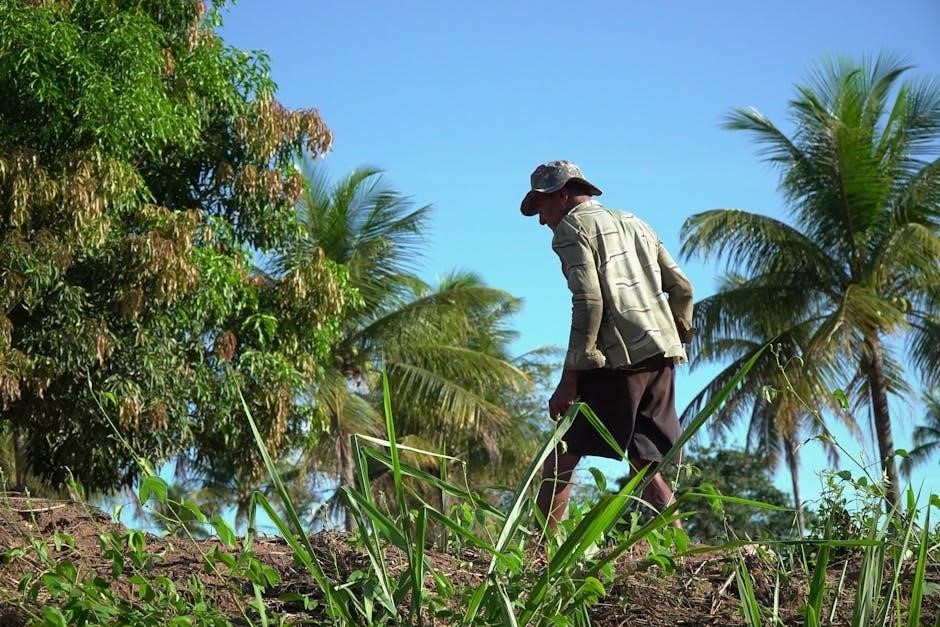Manual soil compaction is a cost-effective method for stabilizing soil in small-scale projects, ensuring even settlement and proper drainage by using basic tools like tampers and plates.
1.1 Importance of Soil Compaction
Soil compaction is essential for creating a stable base for construction, landscaping, or gardening projects. It improves soil density, reducing settling and increasing load-bearing capacity. Proper compaction prevents water pooling, erosion, and uneven surfaces, ensuring long-term structural integrity. By eliminating air pockets, it enhances soil strength and durability, making it resistant to environmental stresses. Effective compaction is crucial for projects like pathways, foundations, and lawns, ensuring safety and longevity. Regular compaction maintains soil health and prevents future issues, making it a fundamental step in ground preparation.
1.2 Overview of Manual Methods
Manual soil compaction involves using handheld tools to densify the soil. Common methods include tamping with hand tampers or utilizing manual plate compactors. These tools are effective for small areas and provide precise control. The process typically involves soaking the soil to reduce friction, then applying repetitive force to compress it. Manual methods are cost-effective, require minimal equipment, and are ideal for DIY projects or areas inaccessible to heavy machinery. They ensure even compaction without the need for specialized skills, making them suitable for various applications.
Tools and Equipment Needed
Manual soil compaction requires basic tools like a hand tamper, manual plate compactor, and a water source. These tools ensure effective and efficient soil densification.
2.1 Hand Tamper
A hand tamper is a simple, essential tool for manual soil compaction. It typically features a flat, heavy base attached to a long handle. This tool allows for targeted compaction, making it ideal for small areas or uneven ground. By repeatedly pressing down with the tamper, air pockets are eliminated, and the soil becomes more stable. Its portability and ease of use make it a favorite for small-scale projects. Regular use ensures even compaction without requiring mechanical assistance.
2.2 Plate Compactor (Manual)
A manual plate compactor is a versatile tool designed for efficient soil compaction. It consists of a sturdy steel plate attached to a handle, allowing for even pressure distribution. This tool is ideal for larger areas compared to a hand tamper. By pushing or pulling the compactor, the plate vibrates, compacting the soil effectively. It works best on moist soil, ensuring a firm and stable surface. Regular use helps prevent settling and improves drainage, making it a reliable choice for medium-scale projects; Its manual operation ensures control and precision without mechanical assistance.
2.3 Water Source
A reliable water source is essential for manual soil compaction, as moisture helps bind soil particles together, improving compaction efficiency. Water should be applied evenly to saturate the soil without pooling. A hose or watering can is ideal for this step. Proper hydration ensures the soil reaches optimal density, reducing the risk of settling or shifting after compaction. Always use clean water to avoid contamination, and apply it gradually to allow absorption before proceeding with compaction tools like tampers or plates. This step is critical for achieving a stable and durable surface.

Preparing the Soil
Preparing the soil involves clearing debris, leveling the ground, and soaking the soil to ensure proper moisture levels, which are essential for effective manual compaction and stability.
3.1 Clearing Debris
Clearing debris is the first step in soil preparation. Remove rocks, twigs, and any obstructions that could interfere with compaction. A clean surface ensures even pressure distribution and prevents uneven settling. Use a rake or shovel to collect debris efficiently. This step is crucial for achieving uniform density and stability in the soil, which are essential for successful manual compaction. Neglecting debris removal can lead to air pockets and weak spots in the compacted surface.
3.2 Leveling the Ground
Leveling the ground ensures a uniform surface for compaction. Use a shovel or rake to redistribute soil evenly, filling low spots and removing excess from high areas. Check the surface with a spirit level or string lines to confirm evenness. Proper leveling prevents uneven settling and promotes consistent compaction. It also helps in achieving the desired grade for drainage or structural requirements. A well-leveled surface is essential for effective manual compaction, ensuring stability and longevity of the compacted area.
3.4 Soaking the Soil
Soaking the soil is crucial for effective manual compaction. Water helps bind soil particles together, reducing air pockets and improving density. Use a hose to gently saturate the soil until water pools on the surface. Allow the soil to absorb the water for at least an hour before proceeding. Proper soaking ensures the soil is pliable but not muddy, making it easier to compact evenly. Avoid over-saturating, as this can lead to instability. The ideal moisture level is when the soil holds its shape when squeezed but crumbles slightly when pressed firmly.

Compaction Techniques
Manual soil compaction involves techniques like tamping, plate compacting, and layering to achieve uniform density. Proper moisture levels and consistent pressure are key for effective results.
4.1 Tamping with a Hand Tamper
Tamping with a hand tamper is an effective method for compacting small areas. Start by raising the tamper to a comfortable height and bringing it down forcefully in a consistent motion. Focus on overlapping strokes to ensure even coverage. For best results, work in small sections, repeating the process until the soil feels firm. Avoid using excessive force, which can damage the tool or displace soil unevenly. Proper technique ensures a stable base, making this method ideal for manual compaction projects. Patience and consistency yield the best outcomes.
4.2 Using a Manual Plate Compactor
A manual plate compactor is ideal for larger areas. Start by ensuring the plate is clean and free of debris. Operate it by pushing forward, applying steady pressure, and overlapping passes to cover the entire surface evenly. Work in sections, completing one area before moving to the next. Maintain a consistent pace and avoid rushing to achieve uniform compaction. This method is efficient for deeper layers and ensures a solid foundation. Regularly inspect the plate for wear and clean it to maintain effectiveness.
4.5 Compact in Layers
Compacting soil in layers ensures even density and stability. Begin with the bottom layer, using a hand tamper or plate compactor to press the soil firmly. Work in 4-6 inch thick layers, moistening each layer slightly before compacting. Repeat this process, moving upward, until the desired height is reached. This method prevents settling issues and ensures a strong, even surface. Always check each layer’s firmness before proceeding to the next to achieve optimal results. Layer compaction is especially effective for deeper excavations or foundations.
Troubleshooting Common Issues
Troubleshooting common issues during manual soil compaction involves addressing obstacles like rocks and air pockets. Ensure even compaction and check for firmness regularly to avoid uneven surfaces.
5.1 Dealing with Rocks
When compacting soil manually, rocks can obstruct the process and prevent proper compaction. Large rocks may cause uneven surfaces or prevent the hand tamper or plate compactor from making contact with the soil. To address this, remove any visible rocks or debris before starting. If rocks are deeply embedded, break them into smaller pieces or dig them out. For stubborn rocks, use a shovel or trowel to carefully extract them. Ensure the area is clear to achieve uniform compaction and avoid further issues during the process.
5;2 Avoiding Air Pockets
Air pockets in soil can lead to soft spots and uneven surfaces, compromising the structural integrity of the compacted area. To avoid this, ensure the soil is thoroughly soaked and worked in small sections. Use a hand tamper or manual plate compactor to apply even pressure, breaking down the soil gradually. Compact in thin layers, checking for firmness after each pass. If air pockets form, loosen the soil slightly, re-soak it, and re-compact. Consistent, methodical tamping is essential to eliminate voids and achieve a stable surface.

Safety Considerations
Wear protective gear, including gloves and sturdy boots, to prevent injuries. Use proper lifting techniques to avoid strain, and ensure tools are handled safely to prevent accidents.
6.1 Proper Lifting Techniques
When lifting tools or soil, bend at the knees and keep the load close to your body to maintain balance and reduce strain on your back. Avoid twisting and lift only what you can comfortably carry. Ensure a firm grip on tools to prevent dropping them, and take regular breaks to rest your muscles and avoid fatigue.
6.2 Wearing Protective Gear
Wearing protective gear is essential for safety while manually compacting soil. Use sturdy gloves to protect your hands from blisters and cuts. Safety glasses or goggles can shield your eyes from debris. Wear steel-toe boots or sturdy footwear to prevent injuries from heavy tools or uneven terrain. Additionally, a dust mask can help avoid inhaling soil particles. Proper gear ensures comfort and reduces the risk of accidents, allowing you to work efficiently and safely throughout the compaction process.

Testing the Compaction
Test compaction by pressing the soil firmly; if it resists indentation, it’s well-compacted. Water penetration tests can also verify soil density and stability effectively.
7.1 Checking Firmness
Check the soil’s firmness by pressing it firmly with your foot or hand. Well-compacted soil should feel solid and resist indentation. For a more precise test, use a hand tool like a screwdriver. If it penetrates easily, the soil may need further compaction. Another method is to walk on the compacted area; if it doesn’t shift or soften, it’s likely compacted properly. Additionally, observe water absorption: slow absorption indicates good compaction. Repeat tests after compaction to ensure consistency and stability across the entire surface. This step ensures the soil is ready for its intended use. Proper firmness is crucial for long-term durability.
7.2 Water Penetration Test
The water penetration test assesses how well the compacted soil absorbs water. Gently pour water onto the surface and observe absorption. If water soaks in quickly, the compaction is effective. Slow absorption indicates poorly compacted soil or air pockets. For best results, ensure the soil is moist but not saturated before testing. Avoid creating puddles, as this can mislead results. Repeat the test in multiple areas to ensure uniform compaction. This method is simple yet effective for verifying the soil’s structural integrity and readiness for further use. Proper water absorption ensures long-term stability and durability. Consistent results confirm successful compaction.
Manual soil compaction is a straightforward process requiring proper tools and preparation. Following each step ensures stable, even ground, essential for various projects.
8.1 Summary of Key Steps
Manual soil compaction involves clearing debris, leveling the ground, and soaking the soil. Use tools like hand tamps or manual plate compactors to press the soil firmly in layers. Ensure even compaction by checking for firmness and water penetration. Address obstacles like rocks and avoid air pockets for optimal results. Proper preparation and consistent effort yield a stable surface, crucial for construction and landscaping projects. Follow safety guidelines to prevent injuries and achieve professional-grade compaction.
8.2 Final Tips for Effective Compaction
For optimal results, soak the soil thoroughly before starting and use the right tools for your project size. Compact in thin layers to avoid air pockets and ensure even density. Regularly check for firmness and water penetration to gauge progress. Address rocks or debris promptly to maintain uniformity. Finish with a smooth, even surface and allow the soil to settle before final use. Patience and consistency are key to achieving professional-grade compaction manually.